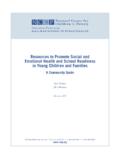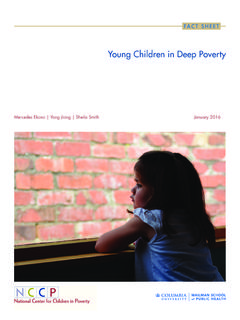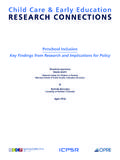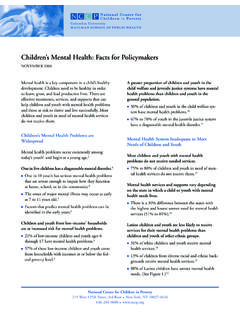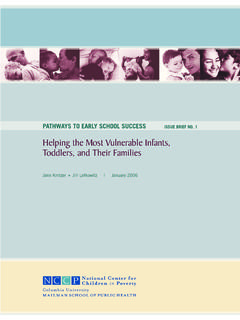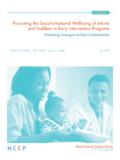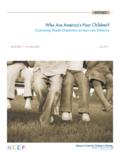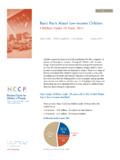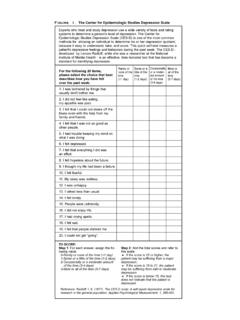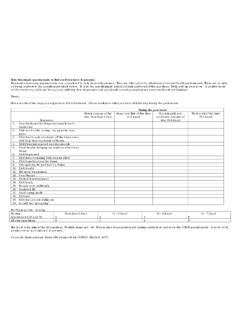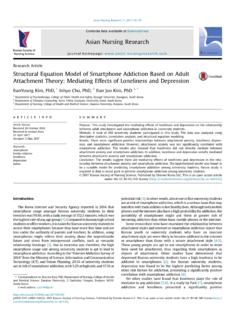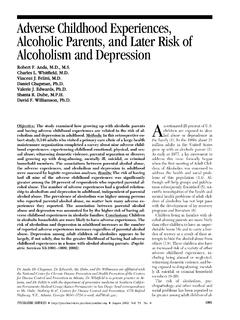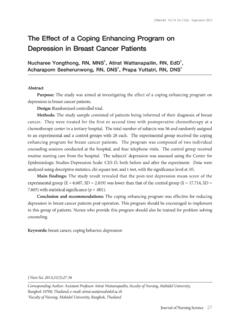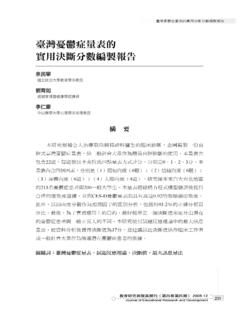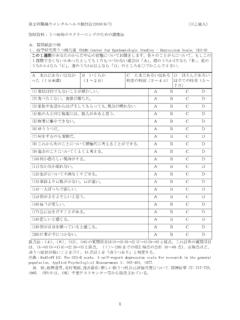Transcription of Depression and Low-Income Women: Challenges …
1 Depression AND Low-Income women : Challenges FOR TANF AND WELFARE-TO-WORK POLICIES AND PROGRAMS Mary Clare Lennon Juliana Blome Kevin English April 2001 Research Forum on Children, Families and the New Federalism National center for Children in Poverty Mailman School of Public Health Columbia University ACKNOWLEDGEMENTS Support for the development of this report has come from the center for Mental Health Services (CMHS) of the Substance Abuse and Mental Health Services Administration (SAMSHA)
2 Of the Department of Health and Human Services. We are grateful to Judith Katz-Leavy of CMHS for her encouragement and support in the development of this report. We are also thankful to Barbara B. Blum, Jane Knitzer, John Lanigan, Susan Mayer, Deborah Phillips and Cybele Raver for helpful comments on earlier drafts of this paper. Beth Hair, Marty Zaslow and S. K. Ahluwalia of Child Trends provided support by analyzing the data from the National Evaluation of Welfare to Work Strategies that are presented in this report.
3 CONTENTS INTRODUCTION 1 THE POLICY CONTEXT 1 Depression AND ITS SYMPTOMS 2 ASSESSMENT OF Depression 3 PREVALENCE OF Depression IN THE POPULATION 4 Depression and Socioeconomic Status 4 MAJOR Depression AND DEPRESSIVE SYMPTOMS IN women ON WELFARE 5 Studies of major depressive disorder 5 Studies of depressive symptoms 7 EMPLOYMENT: ITS RELATION TO Depression 9 Depression as a Barrier to Employment 9 Depression as a Barrier to Job Retention 10 Depression as Result of Job Characteristics 11 Depression as a Result of Unemployment 11 THE TROUBLING CONSEQUENCES OF MATERNAL Depression FOR CHILDREN 12 Pathways of Influence 13 Methodological Issues Limiting Generalizations 14 TREATMENT OF Depression 14 Guidelines for the Treatment of Depression 14
4 Treatment Efficacy 15 ALTERNATIVE INTERVENTIONS 17 TREATMENT IN THE GENERAL POPULATION 18 DISPARITIES IN THE TREATMENT OF Depression 18 CARE RECEIVED ONCE ACCESS HAS BEEN ACHIEVED 20 BARRIERS TO TREATMENT 20 Institutional Barriers 21 Provider Barriers 22 Patient Barriers 23 SCREENING AND ASSESSMENT: IMPLICATIONS FOR TANF AND WELFARE-TO WORK PROGRAMS 23 Screening Tools 24 Revealing Personal Information 24 Confidentiality 25 Diagnostic Assessment 25 Delivery of Services 25 System Changes 25 RESEARCH ISSUES 25 POLICY ISSUES 27 REFERENCES 29 LIST OF FIGURES AND TABLES Figure 1: Twelve-month and lifetime prevalence of Major Depressive Disorder by Gender 3 Figure 2.
5 Major Depressive Disorder among welfare populations (CIDI) 6 Figure 3: Depressive symptoms among welfare Populations 8 Figure 4: Antidepressant prescription by insurance type 19 Table 1: Efficacy rates by psychotherapy class 15 Table 2: Efficacy rates of antidepressant medications 16 Table 3: Mental Health specialty treatment in the United States and Ontario 18 Depression and Low-Income women : Challenges for TANF and Welfare-to-Work Programs and Policies INTRODUCTION This report reviews the literature on the prevalence, treatment, and consequences of Depression for Low-Income women and their children.
6 It highlights the relation of Depression to welfare, employment and job retention and describes findings on the relation of unemployment and poor quality jobs to Depression . Depression is a debilitating illness, characterized by profound feelings of sadness, low mood, and loss of interest in usual activities, that can have severe adverse effects, not only on the individual but also on her job and family life. The recent changes in welfare policy in the United States, including the five-year lifetime limit on assistance and the requirement that recipients obtain jobs after two years of continuous support, have generated concern about Depression , and other problems, in women on welfare.
7 The research findings reviewed have a range of implications for Temporary Assistance to Needy Families (TANF) and welfare-to-work policies and programs, which are outlined in this report. The research review also uncovers areas for new research focused specifically on Low-Income women and their mental health needs. THE POLICY CONTEXT With the passage of the Personal Responsibility and Work Opportunity Reconciliation Act (PRWORA) in 1996, welfare policy in the United States changed dramatically. From the previous entitlement system (Aid to Families with Dependent Children-AFDC), welfare became a time-limited and employment-contingent program.
8 PRWORA replaced AFDC with TANF Temporary Aid to Needy Families. As specified in the name of the program, TANF was designed to provide temporary support, unlike AFDC, which had no time limit on receipt of cash assistance to eligible individuals. The new federal legislation set a five-year lifetime limit for cash assistance and a work requirement after two consecutive years of aid. Within these (and other) broad federal mandates, states and localities could establish their own welfare policies and programs, using monies provided in the form of a block grant, along with their state s matching dollars (maintenance of effort).
9 Given state and local variations in welfare programs and in resources and service delivery systems, the expected effects of welfare reform will not be uniform across locales or individuals. While some TANF participants are able to establish ties to the work force, others find movement into employment more difficult, even with a strong economy. In this latter group, cognitive deficiencies, substance abuse, domestic violence, and mental illness or co-occurring conditions (dual diagnosis or comorbid cases) may compound limited education, training, and ties to the labor force.
10 In addition, there are individuals who voluntarily exit or are diverted from TANF altogether, but who have not yet entered the work force; there are also others who are sanctioned for non-compliance with welfare regulations. They, too, may experience the same types of obstacles to employment. The possibility that mental health problems, especially Depression and substance abuse, may be found among all of these groups has become salient for state policymakers and program operators who, faced with time-limited welfare, must decide how best to address these issues.
